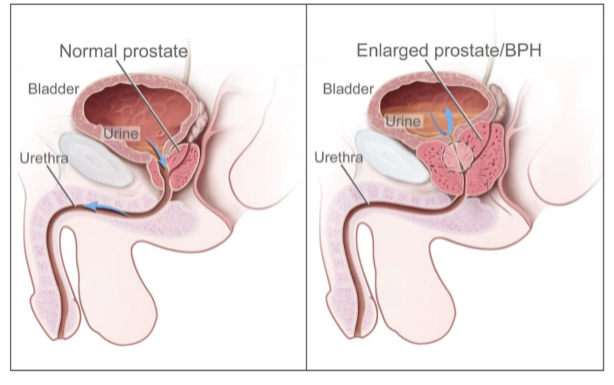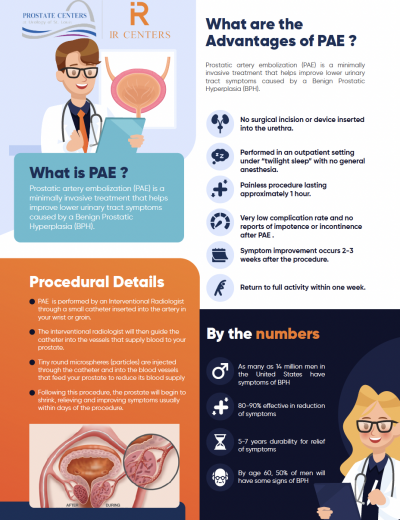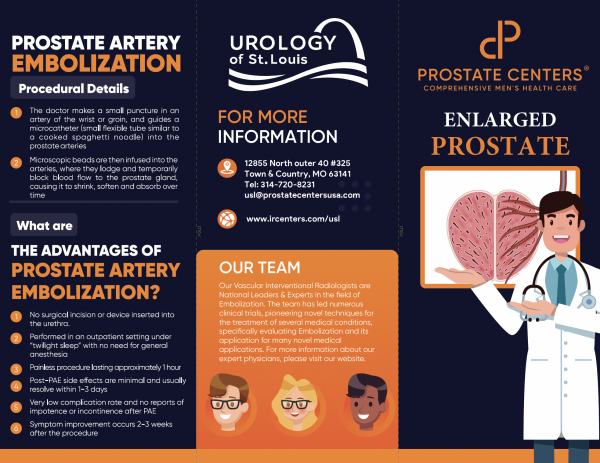Prostate Artery Embolization
Prostate enlargement (BPH) Is a common condition that affects most men, starting at age 40.

Prostate Centers at Urology of St. Louis | IR Centers
As a leader in comprehensive urologic care, Prostate Centers at Urology St. Louis is proud to offer a new minimally invasive treatment option for the treatment of enlarged prostate in our new, office-based, outpatient Interventional Radiology suite located in the Walker Medical Building. Patients are treated with personalized care by our staff and physician on the day of their procedure. No general anesthesia is required, and the patient can return home within hours of the procedure.
We are located in the Walker Medical Building at:
12855 North Forty Drive
North Tower, Suite 325
St. Louis, MO 63141

By Unknown author – National Cancer Institute, AV Number: CDR462221, Public Domain, commons.wikimedia.org/w/index.php?curid=5581217
What is prostate artery embolization (PAE) and how does it work?
A new procedure known as prostate artery embolization (PAE) has emerged as an alternative to more invasive surgical procedures.
In PAE, small particles are injected directly into the arteries (blood vessels) that supply blood to the prostate, leading to devascularization (decrease in blood supply) of the obstructive portion of the prostate.
As the prostate reduces in size (because the blood supply is slowed), obstruction along the urinary pathway is lessened and pressure on the bladder is reduced.
How severe are your symptoms?
The International Prostate Symptom Score (IPSS) questionnaire was developed to measure the severity of your BPH symptoms. Your score is not meant to provide medical advice or replace your doctor’s expert opinion and care. Only your doctor can diagnose whether you have BPH and assess your individual condition. There are other conditions that can cause urinary symptoms besides BPH.
Where does prostate artery embolization fit in with the other treatment options for BPH?
Urinary discomfort associated with an enlarged prostate is generally managed with procedures such as TURP, greenlight laser, and HOLEP, which remove the part of the prostate that blocks the urinary pathway. Patients can benefit from these procedures, but they can also be associated with potentially serious side effects, such as sexual dysfunction, bleeding (which may require blood transfusion), and incontinence.
Alternative minimally invasive surgery options like Urolift and Rezum are also available today. Minimally invasive procedures, however, are limited by the size of the prostate, and they are less likely to provide benefit when the prostate is too large.
Lower urinary tract symptoms associated with prostate enlargement (BPH) are increasingly being treated with PAE. As an alternative to surgical procedures, it offers an innovative and effective treatment option with fewer treatment-related hazards.
How is prostate artery embolization done?
An interventional radiologist performs the PAE procedure using a tiny catheter placed through the femoral artery in the groin and directed to the prostate artery under x-ray vision. Small particles are then injected into the prostate artery reducing the blood supply to the prostate.
The procedure is outpatient and only requires sedation, or a “twilight sleep”, and doesn’t require general anesthesia.
Ready to learn more?
What are the benefits? What are the potential hazards?
PAE can improve urination along with reducing other bothersome symptoms and improving quality of life.
There is a potential burden associated with the treatment, including the temporary presence of blood in the urine or semen, as well as an increase in urinary frequency (typically for 5-7 days).
The possibility of urinary tract infection, urinary catheterization, or skin discoloration is rare. In most cases, the procedure does not cause bothersome pain to the patient. There is also no need to place a urinary catheter or anything via the penis as part of the procedure.
Contact Us Online
- Schedule An Appointment
PAE | IR centers
Make an Appointment
We welcome new patients and patients from our former practices. Please call your local office to make an appointment.



